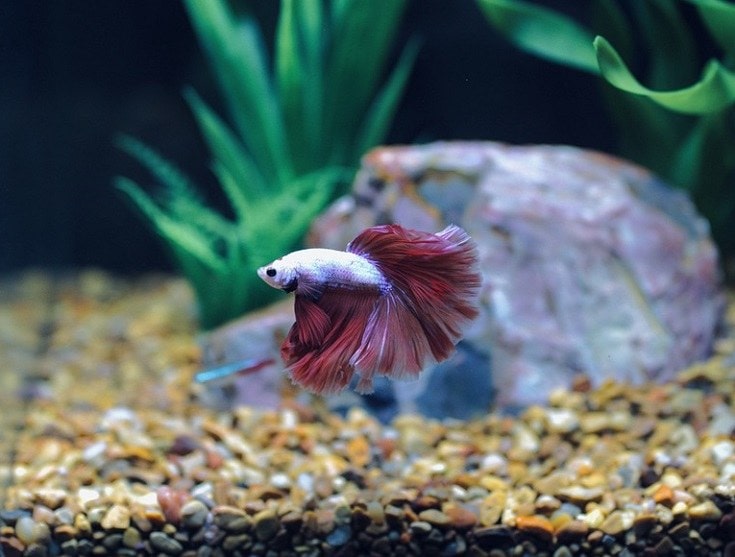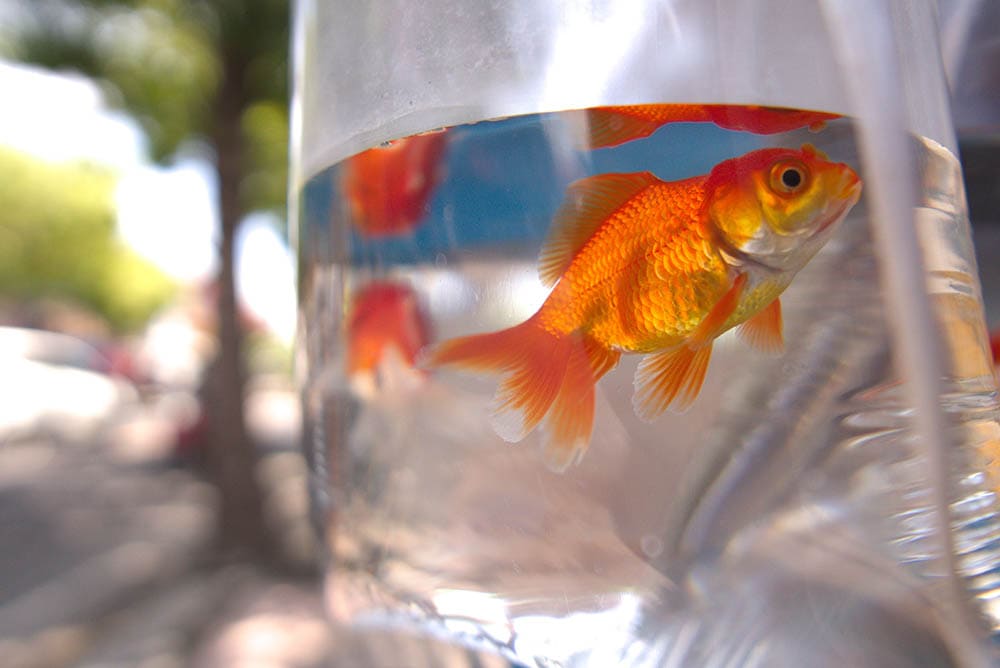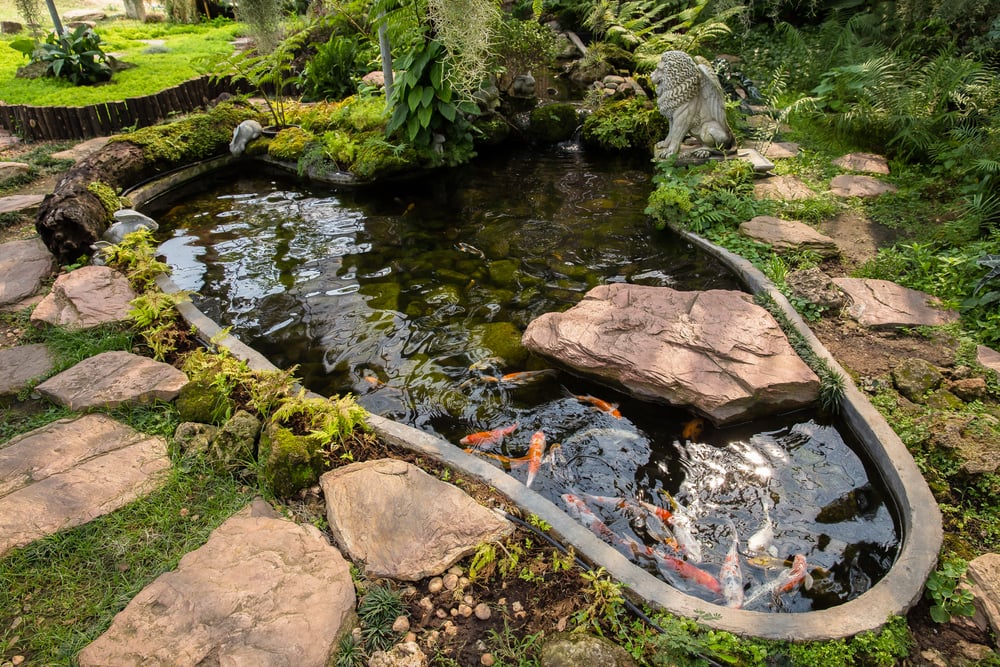Deciding to add plant life to your aquarium might seem like a no-brainer because of the added benefits to tank life. However, buying compatible aquatic plants can be tricky—plus, it incurs another point of care on top of routine maintenance.
If you’re on the hunt for new plants for your lovely setup, we found several that we think you’ll love. Depending on the purpose and overall aesthetic, the plant you pick might be different from our favorites, but let’s check out these reviews!
A Quick Comparison of Our Favorites
| Image | Product | Details | ||
|---|---|---|---|---|
| Best Overall |

|
Java Moss |
|
Check Price |
| Best Value |

|
G’z 3 Water Wisteria |
|
Check Price |
| Premium Choice |

|
Heirloom Garden Rotala Rotundifolia |
|
Check Price |

|
Planterest Anacharis |
|
Check Price | |

|
Generic Ludwigia Ruby |
|
Check Price |
The 8 Best Aquarium Stem Plants
1. Java Moss – Best Overall
| Growth rate: | Slow |
| Max height: | 2-4 inches |
| Light demands: | Low/medium |
| CO2: | Optimal |
| Difficulty: | Easy |
| Placement: | Foreground |
When it comes to our favorite overall aquarium stem plants, we have to give the win to Planerest Java Moss. It is super easy to grow and won’t take over your tank. It’s also readily available in most aquarist locations, both physically and online.
This is a pretty hands-free plant once you start it, but it’s sturdy enough that your fish will likely leave it intact. The plant comprises a series of small stems, considered a foreground plant that attaches to driftwood, rocks, and other root systems.
We received our order in a 2-inch cup sporting healthy plant life that was living on arrival, holding the 7-day live guarantee. The company even lets you add “ice” or “heat” to your product order so they can take care of your plant correctly, depending on your environment.
Overall, the Java moss was easy to get started, and it looks fabulous in virtually any tank. Since it doesn’t take up too much space or grow out of control, it makes an excellent pick for novice and experienced growers alike.
Java moss, while low maintenance, thrives better with liquid fertilizer. So, occasionally giving the plants a nutritional boost will keep your plants bright green and growing as they should. For big and small setups, we think you’ll love the Java moss as much as we did.
However, if you’re looking for a plant with some height, this isn’t the best pick. Read on!
2. G’z 3 Water Wisteria – Best Value
| Growth rate: | Fast |
| Max height: | 24 inches |
| Light demands: | Moderate |
| CO2: | Optional |
| Difficulty: | Easy |
| Placement: | Carpet, background |
When it comes to value, we recommend G’z 3 Water Wisteria. You get a total of three live plants at a reasonable cost—staying under just a few dollars per plant. We think it’s honestly the best aquarium stem plant we could find for the money.
Not only is this plant affordable—it’s simply beautiful, creating an authentically natural aesthetic. The growth is top-notch, sprouting bright green interesting leaves. Because of the growth design, it makes an excellent shelter for shy fish who need a little getaway.
When your water wisteria arrives, you’ll notice these plants don’t have roots—that’s totally normal. Once you plant them into a suitable substrate, they will automatically start to root on their own. Water wisteria does best in a sandy substrate that is nutrient-packed.
However, if you are trying to propagate this plant, we found that gravel substrate works best, as female plants release sprouts with ease. All water wisteria has antimicrobial properties that help your tank life flourish.
Water wisteria requires medium light and will not do well in low-light tanks. Not only will it lack proper nutrients, but it will also actually stop producing oxygen. So, if you have a low-light setup, this might not be the best choice for you.
Housing a goldfish isn't as simple as buying a bowl. If you're a new or experienced goldfish keeper who wants to get the setup right for your goldfish family, check out the best-selling book, The Truth About Goldfish, on Amazon.
It covers all you need to know about the ideal tank setup, tank size, substrate, ornaments, plants, and so much more!
3. Heirloom Garden Rotala Rotundifolia– Premium Choice
| Growth rate: | Fast |
| Max height: | 6 inches |
| Light demands: | Moderate/high |
| CO2: | Not necessary |
| Difficulty: | Easy/moderate |
| Placement: | Background |
If you want to add a little pizazz to your setup and don’t mind paying a few extra dollars, we must recommend Heirloom Garden Rotala Rotundifolia. It is exceptionally lovely in most aquatic seascapes, along with a plethora of other upsides.
What we absolutely love is that you can buy this beautiful plant in a variety of colors. You can choose between red, dark green, pink, or green if you prefer. You could even get a little mixtape for a really intriguing aesthetic.
This plant is very easy to grow, taking off on its own and thriving accordingly. It makes a lovely background plant, growing up to six inches tall. Since it grows quickly, you might have to trim often to keep growth desirable.
Light is key to giving Rotala its intense coloration. The brighter you want your plant, the more light you should give it. This plant has a very fast growth rate, growing a whopping one inch per week. So, if you’re looking for a slow grower, this isn’t the one.
4. Planterest Anacharis
| Growth rate: | Fast |
| Max height: | 3+ feet |
| Light demands: | Moderate/high |
| CO2: | Not necessary |
| Difficulty: | Easy |
| Placement: | Mid-background |
Planterest Anacharis is a favorite among enthusiasts and goes by other names like Elodea and waterweeds. It is one of the more popular and readily available plants in the aquatic plant world. It is pretty much impossible to kill unless you keep it in low light or smother the roots.
This plant can grow rapidly, permitting that it has an adequate light source, fertilizer, and CO2. For slower growth, you don’t have to provide supplements for the plants to stay healthy. But still, make sure your Anacharis gets moderate to high light.
You can propagate Anacharis with ease, cutting off sections of stems. You can easily create a lovely setup with only a few Anacharis plants and propagation. If you don’t want these plants to take over the tank, monitor new growth and keep the plans tidy.
These plants come with a heat or ice pack as requested—and have a 7-day live guarantee. They might not look like much at first, but they will thrive in no time.
5. Generic Ludwigia Ruby
| Growth rate: | Fast |
| Max height: | 12-20 inches |
| Light demands: | Moderate/high |
| CO2: | Required |
| Difficulty: | Easy |
| Placement: | Mid-background plant |
We were pretty impressed with our Generic Ludwigia Ruby plant. It was vibrant and healthy upon arrival, upholding the company policy of live plants.
This plant is a perfect selection for mid to background placement. They grow to suit the environment. Unlike some other aquatic plants, to achieve rich color, these plants need adequate bright light and C02 supplementation.
Ludwigia plants are easy to grow, providing lovely aquatic foliage in even colder temperatures. These plants thrive in waters in the mid-70s but can manage in even colder temperatures (as low as 59-degrees.)
What’s really nifty about this plant is that it has a 100% live guarantee—and came to us in excellent condition. The coloration of the plant is stunning, sprucing up even the fullest landscapes.
This cold-hardy plant is adaptable and beautiful. However, it needs C02 to thrive.
6. Mainam Moneywort Bacopa Monnieri Bundle
| Growth rate: | Fast |
| Max height: | 10 inches |
| Light demands: | Moderate/high |
| CO2: | Not necessary |
| Difficulty: | Easy |
| Placement: | Mid-background |
If you don’t have any bacopa yet, we have to encourage you to check out the Mainam Moneywort Bacopa Monnieri Bundle. The company offers a three-day live guarantee to ensure the starting success of your aquatic garden.
Bacopa Monnieri is also known as moneywort, a medicinal plant used for centuries in tribes across India for Ayurvedic traditions. It is an excellent choice for aquariums because it thrives in just about any setting, and it’s compatible with nearly all fish.
While this plant is super easy to care for, it does require a decent amount of light. If the plant is in a low-light setting, it will start to rot. So, it’s imperative to give it enough.
Bacopa is a simple plant that grows bright green sprouts on stalls. Propagation is an absolute breeze. You can easily cut stems from existent plants, and they will take root just like that.
What’s interesting about bacopa is that it can be totally submerged. However, when it emerges from the water, it thrives and grows tiny, charming white flowers.
Even though this plant can be a good choice for beginners, proper conditions are essential.
7. Greenpro Hornwort
| Growth rate: | Fast |
| Max height: | 10 inches |
| Light demands: | Low |
| CO2: | Not necessary |
| Difficulty: | Easy |
| Placement: | Background |
We have to give a shout-out to the GreenPro Hornwort 3-pack bundle. The plants arrived in mint condition and looked beautiful after setup.
Hornwort, also known as coon tail, is one of the best plants you can get to protect the little guys in your tank. Everything about the way it grows creates excellent coverage.
This plant is also incredibly talented at producing an abundance of oxygen and keeping the tank clean. However, hornwort is a hungry boy—so additional supplements are beneficial, especially if you have other plants. You don’t want them robbed of nutrients.
Planting is generally easy with these plants. All you need to do is expose it to water for a few days until it sprouts baby root hairs—then you can plant it directly into the substrate of your tank.
What’s really cool about the plant is that it makes a really good food source for many fish species to munch on. Plus, once it gets going it’s literally impossible to kill, and it can survive long periods in low light.
8. Mainam Red Myriophyllum
| Growth rate: | Fast, with proper lighting |
| Max height: | 12 inches |
| Light demands: | High |
| CO2: | Required |
| Difficulty: | Difficult |
| Placement: | Mid to background |
As far as coverage goes, Mainam Red Myriophyllum was our favorite, but it won’t work for every tank. Among those we reviewed, this is the hardest to maintain and requires the most work. However, for the proper setup, it would make a stunning addition.
One really awesome aspect of this plant is the growth potential. This light lover reaches toward the rays instantly, emerging from the eater to shoot fascinating pin cushion sprouts.
Since it’s such a light hog, it can shade the water and stop other plants from getting adequate light, so regular pruning is a must. These plants can be tricky to grow if you’re inexperienced. So, you may run the risk of being out of your element at first.
In addition to bright light, this plant also requires high C02 injections and nutritional supplementation.
It’s truly a beautiful and unique stem plant. Nonetheless, it will all depend on if the hassle is worth the reward to you.
Buyer’s Guide: How to Pick the Best Aquarium Stem Plants
If you don’t buy plants much, you might feel a bit out of your element. Don’t worry. Here are what you’re looking for and other considerations.
Aquatic Plant Benefits & Downfalls
If you’re finally deciding to buy aquatic plants, you have probably been through the pros and cons, but hers is a quick look for you—just in case.
Placement
Before you buy, consider your placement and tank size.
Background
Background plants grow to be taller to create a built-up aesthetic.
Tall plants work well, so they don’t block aquatic life or other plants. They grow quite quickly, especially with brighter light.
Background plants are often the best at hiding shy critters from sight or keeping prey safe.
Mid-ground
Mid-ground plants work well in the center of the seascape, not taking up too much room. But they also work as an eye-catcher and another spot to keep tank members tucked away.

Foreground
Foreground plants grow low to create a carpeting or vining effect. Many love these plants for aesthetic purposes.
Plant Care
Additional Supplementation
Some plants require additional supplementation to stay healthy in an indoor setting.
Required Growth Room
Plants will have varying lengths and widths, growing at different rates. So it’s important to know if you have the room for the plants you pick. You can often control growth with lighting and pruning.

Plant Pruning & Maintenance
Some plants grow very well on their own, while others require pruning. If you don’t want the hassle of plant care, buy plants that will self-sustain.
Conclusion
We realize you’ll have specific requirements for pal a in your setup, but we stand by our number one—Planterest Java Moss. It’s super easy to grow, has small stems, and works well in modest and extravagant setups.
If you want to have a few bucks, G’z 3 Water Wisteria is quite a steal. It comes in a bundle of three and provides fast coverage. It’s both aesthetically pleasing and a suitable shelter for tank dwellers.
You can buy one or several of these plants, permitting they have the exact environmental requirements to be compatible.
Featured Image Credit: J Cruikshank, Unsplash






















